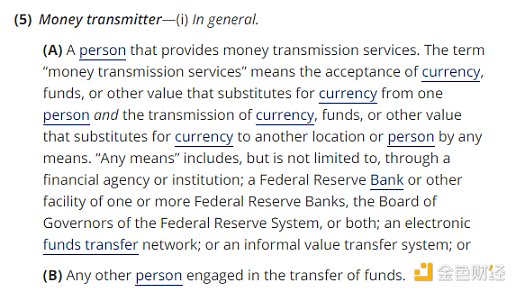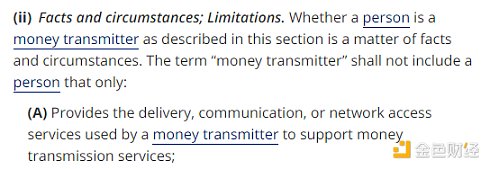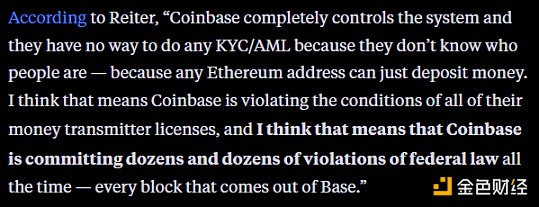Author: Adam Cochran, Partner at Cinneamhain Ventures, Source: Author’s Twitter @adamscochran; Translation: Luffy, Foresight News
Coinbase’s L2 scaling network Base has gained popularity due to friend.tech. However, blockchain analytics firm ChainArgos points out that Base may violate US federal laws. In response, Adam Cochran, partner at Cinneamhain Ventures, wrote that ChainArgos’ view lacks technical and legal knowledge, and he believes that decentralized L2 is fully compliant with US laws. Foresight News has translated Adam Cochran’s tweet:
Coinbase’s Base chain does not violate federal laws.
ChainArgos’ view is a dishonest legal argument, and it lacks technical knowledge, attempting to sell more on-chain risk monitoring/reporting software to L2 than they actually need. Ultimately, ChainArgos either maliciously interprets or lacks technical understanding of the meaning of “custody” in blockchain or L2.
- Adam Cochran Why Coinbase’s L2 will not violate US laws
- Exclusive Interview with Avalanche VP Ethereum is not the complete solution for Web 3
- Proof of Validator The Key Security Puzzle on the Road to Ethereum Scalability
Now let’s analyze why Coinbase’s L2 network does not violate any laws.
First and foremost, in this debate, concepts related to futures, licensed exchanges, OTC brokers, and money transmitters are often confused.
So we must first understand the meaning of “custody” in cryptocurrency.
When you hold, control, or transfer user funds, US laws regarding money transmission apply.
FinCEN (FIN-2019-G001) provides clear guidance, with the key point being key control in the concept of “noncustodial wallet”:

This makes sense, as when you deposit cryptocurrency into a custodial wallet, Coinbase becomes a money transmitter. However, if your keys are in MetaMask, then MetaMask is not a Money Services Business (MSB); it is simply a tool you use to interact with wallets.
In fact, one of the few explicit laws in the US financial industry is the definition of “money transmission” – if any of the following conditions are met, you are a money transmitter:

This led some legal enthusiasts in the 1990s to believe that internet service providers were actually money transmitters. At that time, the legislature enacted section (ii)(A), which stated that service providers offering communication and delivery networks are not money transmitters.

Base is a public blockchain network based on the OP stack, providing communication for self-custodial wallets and DApps, and anyone can participate.
Although its sequencer is currently centralized, it does not automatically mean it is a custodial institution.
You can use “OptimismPortal” to transfer funds between L1 and L2, and the Merkle tree will continuously publish states back to Ethereum L1, with underlying bridged assets stored in L1’s cross-chain bridge.
This means that even if Coinbase shuts down all servers and disappears completely tomorrow, you can still:
-
Sort transactions yourself (with a 12-hour delay) to have them included in L1 without going through L2.
-
Delay withdrawals for 7 days.
You can sort the following transactions yourself, once the transactions are included, you call the following transactions on the Ethereum L1 Base bridge contract and publish the Merkle proof of your withdrawal transaction.

Then, even if Coinbase shuts down the Base network tomorrow, you can still regain control of your assets.

To summarize:
-
Coinbase does not operate the market on Base.
-
Coinbase does not control your keys on Base.
-
If Coinbase shuts down all infrastructure tomorrow, you can still transact.
-
And you can withdraw your assets from L1 at any time.
The ChainArgos team said that because any address can deposit funds into Base, this could bring legal trouble to Coinbase.
In fact, just because it is an open and permissionless network layer, it makes this behavior legal.

Coinbase performs KYC/AML for transactions conducted through Coinbase and also has on-chain monitoring tools.
But legal liability does not extend to their Base chain or the DApps running on it.
Although there is still more work to be done in terms of security and robustness for decentralized L2, they are decentralized enough in terms of legality, with their simplest form being just a smart contract.
It is this fundamental technological difference that defines the boundary between L2 and centralized L1 sidechains, and it is also the reason why Coinbase did not establish some PoA private operational networks.
If L2 is considered an MSB, then all blockchain networks and all smart contracts are de facto money transmission entities.
This is absurd and ridiculous, and the legal and technical expertise of those who propose such views should be questioned.
Like what you're reading? Subscribe to our top stories.
We will continue to update Gambling Chain; if you have any questions or suggestions, please contact us!